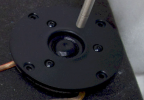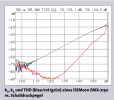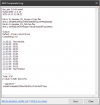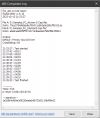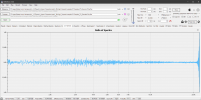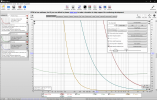As announced long ago the last part on the subject of audibility of capacitor upgrade in crossovers. The comparison ranges from a very cheap, decades-old film capacitor to an expensive high-end capacitor.
As promised, this time there are short audio samples of each capacitor (in a simple crossover) recorded with a microphone via tweeter (test setup see below).

The full mini series:
Capacitor upgrade in crossover - Is it audible?
Capacitor upgrade - part two
Capacitor upgrade - part three
Replace resistor by low-inductance resistor - Is it audible?
Different Binding Posts - is it audible?
Audible difference in high-end capacitors? - ABX samples
Lately there have been YouTube videos and discussions here in the forum for the thousandth time about "capacitor sound" (i.e. the audible difference of film capacitors of the same capacitance in loudspeaker XO, but of different price ranges and manufacturers).
In forums, on websites or in videos you can read or hear something like "Even if the capacitors measure identically, very clear differences can be heard in different price ranges and designs - in short, clearly audible difference, you can't measure".
To end these arguments once and for all (don't worry, I don't believe that myself), here is the ultimate test:
The capacitors are not only measured, but for each capacitor there are also two recorded audio samples, once a few seconds of pink noise and a short sound snippet of the well-known test music track "Fast Car".
Now everyone can easily perform an ABX test (e.g. with foobar) or can hear the diff file of two caps (see section 6 for more details) and decide for themselves how much differences are audible**.
Index:
1) About the high-end capacitor
2) Test setup
3) Measurement consistency
4) Tweeter measurement with different caps
5) Audio recording samples - see post#2
6) Samples analyzed with DeltaWave - see post#2
7) Compare impedance measurements of the caps in REW - see post#2
8) Are there differences in the phase frequency response (i.e. in the "time domain ")? - see post#568
1) About the high-end capacitor
The following statements can be found about the high-end capacitor (3.3µF Alumen-Z-Cap from Jantzen) used:
So, according to these "expert statements" we can assume that the audible differences between the high-end capacitor and the other two capacitors will be dramatically.
Personally, I can hardly stand the tension anymore, how will the measurements and the recordings turn out? Just keep reading...
Just keep reading...
** The recordings were not made in a studio, so I can not exclude that the recordings are possibly distinguishable by background noise (street noise, children's cough, TV sound,...) or editing - if you notice something like that, please report right here in the thread, so that I can possibly exchange the files.
2) Test setup
The test setup is identical to the previous parts of the mini series (see above). To better protect the tweeter, this time an air coil was used to form a second order electrical high pass together with the capacitor.

To measure the next capacitor or to make the next sound recording, only one terminal has to be reconnected to the next capacitor.
This is to prevent the position of the measuring microphone and tweeter from changing in relation to each other.
Audio interface: MOTU UltraLite mk4
Measuring amplifier: Marantz PM7001
Tweeter: SB21RDC tweeter from SBAcoustics
Measuring mic: iSEMcon EMX-7150
Measuring software: Arta (dual channel measurements when possible)
Measurements itself:
10s of pink noise, 1s pause and then the measurement (for best possible consistency).
The SPL of the measurements were 72dB@1kHz@1m and 90dB@10kHz@1m, more details see the calibrated HD measurement:
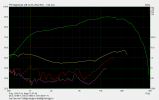
This SPL should be above the usual listening volume. The tweeters with ring radiator have slightly higher HD2 (but this HD2 will be completely masked) and very low harmonic distortion of higher order. Only the tweeter with ring radiator showed very good consistency, so it was used.
The most important thing, of course, is that the capacitance of the capacitors is almost identical. I have about 30 pieces of the 3.3µF standard film capacitors (about 1$) in stock, so it was possible to find an almost identical capacitance to the 3.3µF high-end Alumen-Z-Cap from Jantzen - which costs about 45$ per piece (was purchased only for you dear reader ).
).
There were also dozens of very old 1µF film capacitors (about 0.05$ each), of which three pieces together (plus a 0.27µF correction capacitor for 0.5$) make the cheapest and oldest 3.3µF capacitor in the test.
Test cap capacitance and deviation
Jantzen Alumen-Z-Cap (45$): 3.289µF
Standard-Cap (MKP 400V Arcotronics, 1$)***: 3.288µF (deviation <0.05% to Alumen-Z-Cap)
Old-Cap (MKT 100V TGL, 0.15$): 3.292µF (deviation <0.1% to Alumen-Z-Cap)
(measured with TH2821 LCR meter @1kHz)
*** good standard quality MKP cap probably cost you 3-4$ per piece for 3.3µF
The differences of the capacitors can be measured without any problems. Here the behavior of the capacitors at 1kHz and 10kHz the order is always
Alumen-Z-Cap, Standard-Cap and Old-Cap @1kHz:


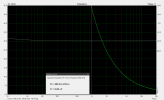
Alumen-Z-Cap, Standard-Cap and Old-Cap @10kHz:

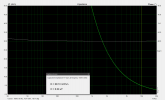
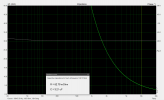
It is easy to see that the resistive part of the capacitors are quiet different and that the difference increases with higher frequencies.
This corresponds to what one would expect from a capacitor, since unwanted (parasitic) properties exist in addition to capacitance. The equivalent circuit of a capacitor looks like this:

Source: https://www.elektronik-kompendium.de/sites/bau/0205141.htm
The most important unwanted properties are (the frequency dependent) Equivalent Series Inductivity ESL and Equivalent Series Resistance ESR. However, certain properties often only come into play at very high frequencies in the MHz range or above.
3) Measurement consistency
To get an impression how consistent the frequency response measurements of the tweeter and approximately how large the errors of the measurement are, a capacitor is measured twice with time between the measurements.
The first image shows the FR of the two measurements. The second image shows the FR normalized to one measurement with a very high resolution of only +-0.5dB:
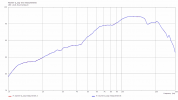
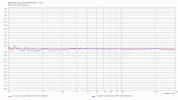
In the frequency range 1-30kHz, the two measurements differ by a maximum of +-0.04dB. Put simply, this is probably roughly our measurement error.
Below 1000Hz the SPL of the test signals is so low that ambient noise affects the measurement significantly, therefore all measurement results of the tweeter with the different capacitors were limited to 1kHz to low frequencies:
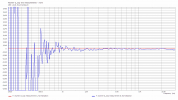
4) Tweeter measurement with different caps
How do these capacitance and resistive differences affect the frequency response emitted by the tweeter? For this we measure the frequency response of the tweeter with the simple crossover for all three capacitors (see test setup above for details) - smoothing is 1/24 oct:
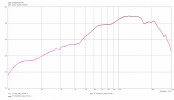
Those who know the other parts will not be surprised, since the capacitors were selected for the best possible capacitance equality, so you can hardly tell the difference in the FR.
To see differences, we normalize the frequency responses to the FR of the Alumen Z-Cap and look how big the deviations of the other two capacitors are to it (attention the scale is +- 0.5 dB, again smoothing is 1/24 oct):

Only the ancient film capacitor with the largest deviation in capacitance and capacitive impedance shows deviation larger than the measurement error (+-0.04dB).
The deviations of -0.1dB around 10kHz are extremely small and should hardly be audible.
To get a complete picture, let's examine the multi-tone distortion (these include HD and inter-modulation distortion) of the high-end capacitor with the standard capacitor:

As expected, the results are nearly identical.
So, the measurements are almost identical, now how drastically will the differences in the recordings be? See next post...
Update 2023-10-17: Added information about measurement equipment. Added Index. Added information about caps.
As promised, this time there are short audio samples of each capacitor (in a simple crossover) recorded with a microphone via tweeter (test setup see below).
The full mini series:
Capacitor upgrade in crossover - Is it audible?
Capacitor upgrade - part two
Capacitor upgrade - part three
Replace resistor by low-inductance resistor - Is it audible?
Different Binding Posts - is it audible?
Audible difference in high-end capacitors? - ABX samples
Lately there have been YouTube videos and discussions here in the forum for the thousandth time about "capacitor sound" (i.e. the audible difference of film capacitors of the same capacitance in loudspeaker XO, but of different price ranges and manufacturers).
In forums, on websites or in videos you can read or hear something like "Even if the capacitors measure identically, very clear differences can be heard in different price ranges and designs - in short, clearly audible difference, you can't measure".
To end these arguments once and for all (don't worry, I don't believe that myself), here is the ultimate test:
The capacitors are not only measured, but for each capacitor there are also two recorded audio samples, once a few seconds of pink noise and a short sound snippet of the well-known test music track "Fast Car".
Now everyone can easily perform an ABX test (e.g. with foobar) or can hear the diff file of two caps (see section 6 for more details) and decide for themselves how much differences are audible**.
Index:
1) About the high-end capacitor
2) Test setup
3) Measurement consistency
4) Tweeter measurement with different caps
5) Audio recording samples - see post#2
6) Samples analyzed with DeltaWave - see post#2
7) Compare impedance measurements of the caps in REW - see post#2
8) Are there differences in the phase frequency response (i.e. in the "time domain ")? - see post#568
1) About the high-end capacitor
The following statements can be found about the high-end capacitor (3.3µF Alumen-Z-Cap from Jantzen) used:
Source: http://www.jantzen-audio.com/alumen-z-cap/The Alumen Z-Cap will offer a more “neutral” presentation in the overall sound in certain crossover designs, and by “neutral” we refer to the focus will be shifted from what in some systems can be a somewhat overemphasized brightness when using a Super MKP capacitor, being replaced with a more even balance between the depth of the midrange and the presence of the tweeter.
Source: http://www.troelsgravesen.dk/Alumen_Z-Cap.htmon the Pawnshop recording and swapping between Sup-Z, Silver-Gold and Alumen-Z was quite a surprise. Suddenly the sheen was gone and the overall sound image appeared darker. "Darker" is mostly a good sign when you know frequency response is exactly the same and yet, the sound becomes darker without any smear of detail. You start listening to treble rather than tweeter or tweeter + capacitor or whatever adds its sonic signature. This sheen also sometimes adds to the perceived sense of detail and transparency. The Alumen-Z appear to present a more credible overtone structure to instruments and voices and most importantly, not diminishing the level of transparency.
Source: http://www.humblehomemadehifi.com/Cap.htmlThe Alumen Z-Cap has high resolution in a natural way, it is without glare that you usually get with some of those "high-end" capacitors. There is an adictive balance between warmth on one side and and openness on the other....The Jantzen Audio Alumen Z-Cap is also open and also has lots of contrast but does it with a warmish undertone. ... The combination of and balance between these characters is spot on and make the Jantzen Audio Alumen Z-Caps create music with a great sense of realism.
So, according to these "expert statements" we can assume that the audible differences between the high-end capacitor and the other two capacitors will be dramatically.
Personally, I can hardly stand the tension anymore, how will the measurements and the recordings turn out?
** The recordings were not made in a studio, so I can not exclude that the recordings are possibly distinguishable by background noise (street noise, children's cough, TV sound,...) or editing - if you notice something like that, please report right here in the thread, so that I can possibly exchange the files.
2) Test setup
The test setup is identical to the previous parts of the mini series (see above). To better protect the tweeter, this time an air coil was used to form a second order electrical high pass together with the capacitor.

To measure the next capacitor or to make the next sound recording, only one terminal has to be reconnected to the next capacitor.
This is to prevent the position of the measuring microphone and tweeter from changing in relation to each other.
Audio interface: MOTU UltraLite mk4
Measuring amplifier: Marantz PM7001
Tweeter: SB21RDC tweeter from SBAcoustics
Measuring mic: iSEMcon EMX-7150
Measuring software: Arta (dual channel measurements when possible)
Measurements itself:
10s of pink noise, 1s pause and then the measurement (for best possible consistency).
The SPL of the measurements were 72dB@1kHz@1m and 90dB@10kHz@1m, more details see the calibrated HD measurement:

This SPL should be above the usual listening volume. The tweeters with ring radiator have slightly higher HD2 (but this HD2 will be completely masked) and very low harmonic distortion of higher order. Only the tweeter with ring radiator showed very good consistency, so it was used.
The most important thing, of course, is that the capacitance of the capacitors is almost identical. I have about 30 pieces of the 3.3µF standard film capacitors (about 1$) in stock, so it was possible to find an almost identical capacitance to the 3.3µF high-end Alumen-Z-Cap from Jantzen - which costs about 45$ per piece (was purchased only for you dear reader
There were also dozens of very old 1µF film capacitors (about 0.05$ each), of which three pieces together (plus a 0.27µF correction capacitor for 0.5$) make the cheapest and oldest 3.3µF capacitor in the test.
Test cap capacitance and deviation
Jantzen Alumen-Z-Cap (45$): 3.289µF
Standard-Cap (MKP 400V Arcotronics, 1$)***: 3.288µF (deviation <0.05% to Alumen-Z-Cap)
Old-Cap (MKT 100V TGL, 0.15$): 3.292µF (deviation <0.1% to Alumen-Z-Cap)
(measured with TH2821 LCR meter @1kHz)
*** good standard quality MKP cap probably cost you 3-4$ per piece for 3.3µF
The differences of the capacitors can be measured without any problems. Here the behavior of the capacitors at 1kHz and 10kHz the order is always
Alumen-Z-Cap, Standard-Cap and Old-Cap @1kHz:



Alumen-Z-Cap, Standard-Cap and Old-Cap @10kHz:



It is easy to see that the resistive part of the capacitors are quiet different and that the difference increases with higher frequencies.
This corresponds to what one would expect from a capacitor, since unwanted (parasitic) properties exist in addition to capacitance. The equivalent circuit of a capacitor looks like this:
Source: https://www.elektronik-kompendium.de/sites/bau/0205141.htm
The most important unwanted properties are (the frequency dependent) Equivalent Series Inductivity ESL and Equivalent Series Resistance ESR. However, certain properties often only come into play at very high frequencies in the MHz range or above.
3) Measurement consistency
To get an impression how consistent the frequency response measurements of the tweeter and approximately how large the errors of the measurement are, a capacitor is measured twice with time between the measurements.
The first image shows the FR of the two measurements. The second image shows the FR normalized to one measurement with a very high resolution of only +-0.5dB:


In the frequency range 1-30kHz, the two measurements differ by a maximum of +-0.04dB. Put simply, this is probably roughly our measurement error.
Below 1000Hz the SPL of the test signals is so low that ambient noise affects the measurement significantly, therefore all measurement results of the tweeter with the different capacitors were limited to 1kHz to low frequencies:

4) Tweeter measurement with different caps
How do these capacitance and resistive differences affect the frequency response emitted by the tweeter? For this we measure the frequency response of the tweeter with the simple crossover for all three capacitors (see test setup above for details) - smoothing is 1/24 oct:

Those who know the other parts will not be surprised, since the capacitors were selected for the best possible capacitance equality, so you can hardly tell the difference in the FR.
To see differences, we normalize the frequency responses to the FR of the Alumen Z-Cap and look how big the deviations of the other two capacitors are to it (attention the scale is +- 0.5 dB, again smoothing is 1/24 oct):
Only the ancient film capacitor with the largest deviation in capacitance and capacitive impedance shows deviation larger than the measurement error (+-0.04dB).
The deviations of -0.1dB around 10kHz are extremely small and should hardly be audible.
To get a complete picture, let's examine the multi-tone distortion (these include HD and inter-modulation distortion) of the high-end capacitor with the standard capacitor:

As expected, the results are nearly identical.
So, the measurements are almost identical, now how drastically will the differences in the recordings be? See next post...
Update 2023-10-17: Added information about measurement equipment. Added Index. Added information about caps.
Last edited:

